Christopher Marlowe: Life, Influence, and Works of a Mystery Tragedian
VerifiedAdded on 2023/06/15
|6
|1714
|339
Essay
AI Summary
This essay delves into the life and influence of Christopher Marlowe, a prominent Elizabethan playwright who significantly impacted English Renaissance drama and paved the way for future dramatists like William Shakespeare. Marlowe's innovative use of blank verse and his exploration of ambitious protagonists set him apart from his contemporaries. The essay discusses Marlowe's biographical details, literary achievements, and unique dramatic techniques, highlighting his contributions to the development of English tragedy and his exploration of themes such as love, power, and human vulnerability. The analysis encompasses his famous works like Edward II, Hero and Leander, and The Tragical History of the Life and Death of Doctor Faustus, drawing connections between Marlowe's works and those of Shakespeare, illustrating their intertwined biographical and artistic relationship. The essay concludes by emphasizing Marlowe's lasting legacy and his role in shaping the landscape of English literature.
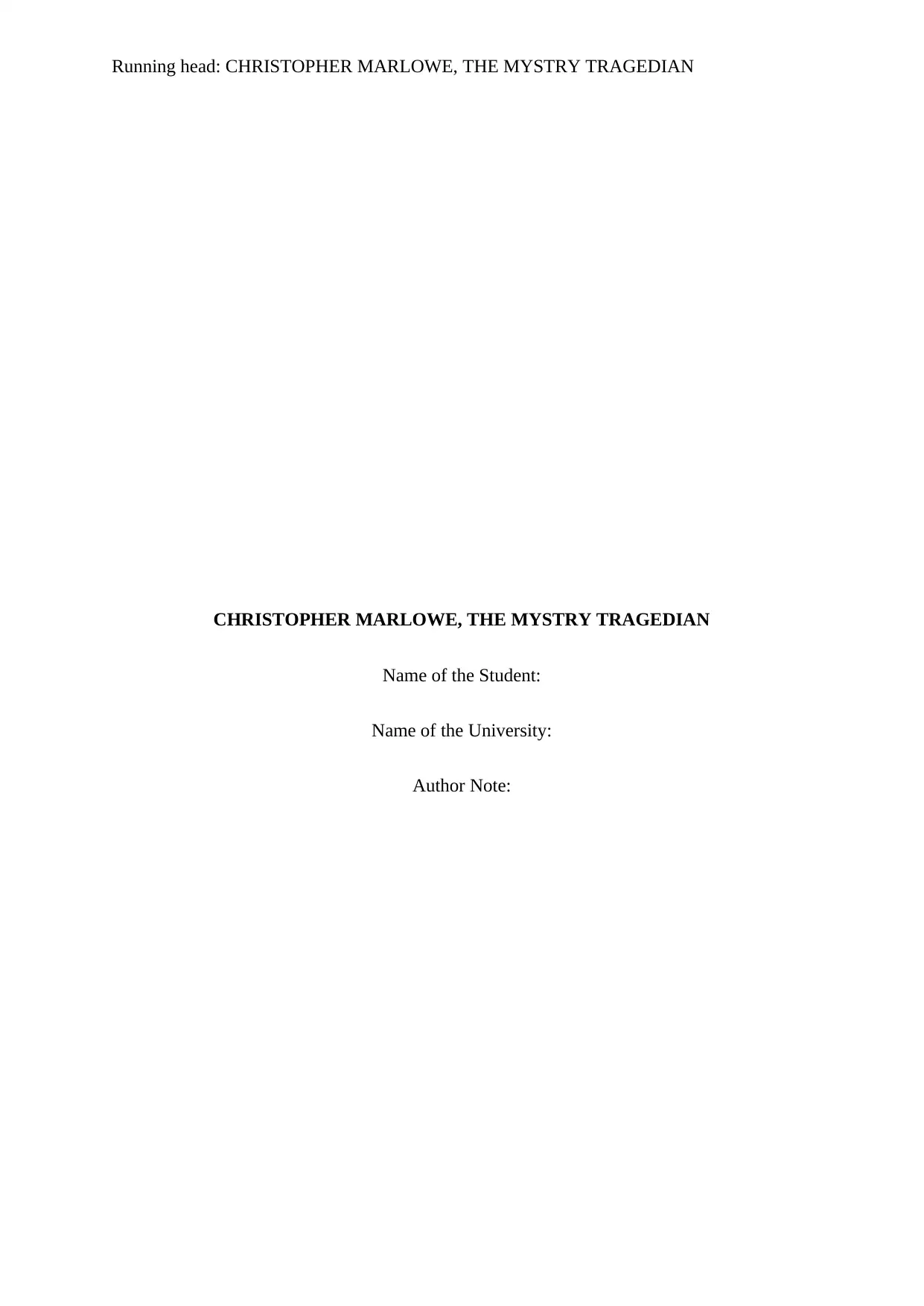
Running head: CHRISTOPHER MARLOWE, THE MYSTRY TRAGEDIAN
CHRISTOPHER MARLOWE, THE MYSTRY TRAGEDIAN
Name of the Student:
Name of the University:
Author Note:
CHRISTOPHER MARLOWE, THE MYSTRY TRAGEDIAN
Name of the Student:
Name of the University:
Author Note:
Paraphrase This Document
Need a fresh take? Get an instant paraphrase of this document with our AI Paraphraser
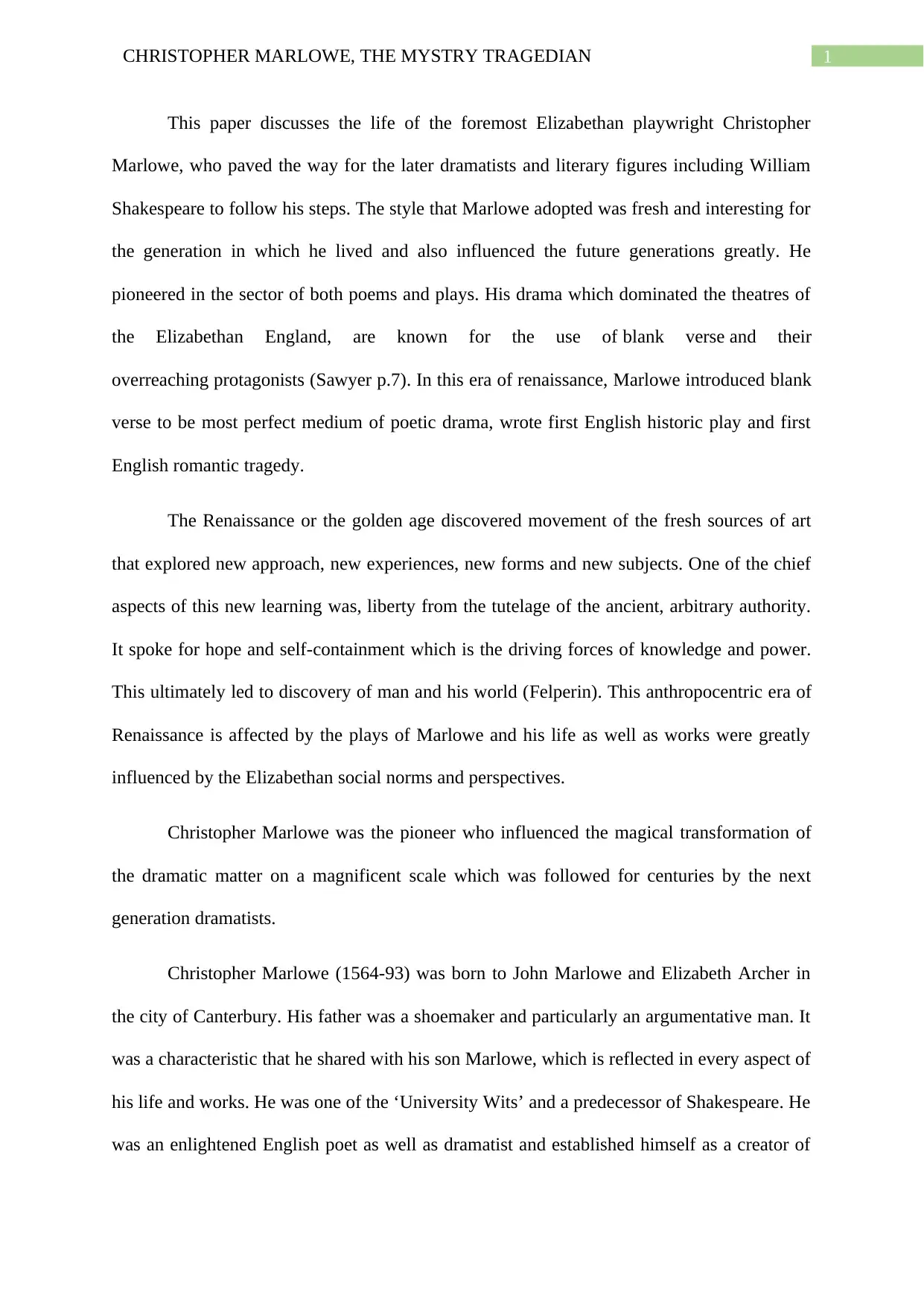
1CHRISTOPHER MARLOWE, THE MYSTRY TRAGEDIAN
This paper discusses the life of the foremost Elizabethan playwright Christopher
Marlowe, who paved the way for the later dramatists and literary figures including William
Shakespeare to follow his steps. The style that Marlowe adopted was fresh and interesting for
the generation in which he lived and also influenced the future generations greatly. He
pioneered in the sector of both poems and plays. His drama which dominated the theatres of
the Elizabethan England, are known for the use of blank verse and their
overreaching protagonists (Sawyer p.7). In this era of renaissance, Marlowe introduced blank
verse to be most perfect medium of poetic drama, wrote first English historic play and first
English romantic tragedy.
The Renaissance or the golden age discovered movement of the fresh sources of art
that explored new approach, new experiences, new forms and new subjects. One of the chief
aspects of this new learning was, liberty from the tutelage of the ancient, arbitrary authority.
It spoke for hope and self-containment which is the driving forces of knowledge and power.
This ultimately led to discovery of man and his world (Felperin). This anthropocentric era of
Renaissance is affected by the plays of Marlowe and his life as well as works were greatly
influenced by the Elizabethan social norms and perspectives.
Christopher Marlowe was the pioneer who influenced the magical transformation of
the dramatic matter on a magnificent scale which was followed for centuries by the next
generation dramatists.
Christopher Marlowe (1564-93) was born to John Marlowe and Elizabeth Archer in
the city of Canterbury. His father was a shoemaker and particularly an argumentative man. It
was a characteristic that he shared with his son Marlowe, which is reflected in every aspect of
his life and works. He was one of the ‘University Wits’ and a predecessor of Shakespeare. He
was an enlightened English poet as well as dramatist and established himself as a creator of
This paper discusses the life of the foremost Elizabethan playwright Christopher
Marlowe, who paved the way for the later dramatists and literary figures including William
Shakespeare to follow his steps. The style that Marlowe adopted was fresh and interesting for
the generation in which he lived and also influenced the future generations greatly. He
pioneered in the sector of both poems and plays. His drama which dominated the theatres of
the Elizabethan England, are known for the use of blank verse and their
overreaching protagonists (Sawyer p.7). In this era of renaissance, Marlowe introduced blank
verse to be most perfect medium of poetic drama, wrote first English historic play and first
English romantic tragedy.
The Renaissance or the golden age discovered movement of the fresh sources of art
that explored new approach, new experiences, new forms and new subjects. One of the chief
aspects of this new learning was, liberty from the tutelage of the ancient, arbitrary authority.
It spoke for hope and self-containment which is the driving forces of knowledge and power.
This ultimately led to discovery of man and his world (Felperin). This anthropocentric era of
Renaissance is affected by the plays of Marlowe and his life as well as works were greatly
influenced by the Elizabethan social norms and perspectives.
Christopher Marlowe was the pioneer who influenced the magical transformation of
the dramatic matter on a magnificent scale which was followed for centuries by the next
generation dramatists.
Christopher Marlowe (1564-93) was born to John Marlowe and Elizabeth Archer in
the city of Canterbury. His father was a shoemaker and particularly an argumentative man. It
was a characteristic that he shared with his son Marlowe, which is reflected in every aspect of
his life and works. He was one of the ‘University Wits’ and a predecessor of Shakespeare. He
was an enlightened English poet as well as dramatist and established himself as a creator of
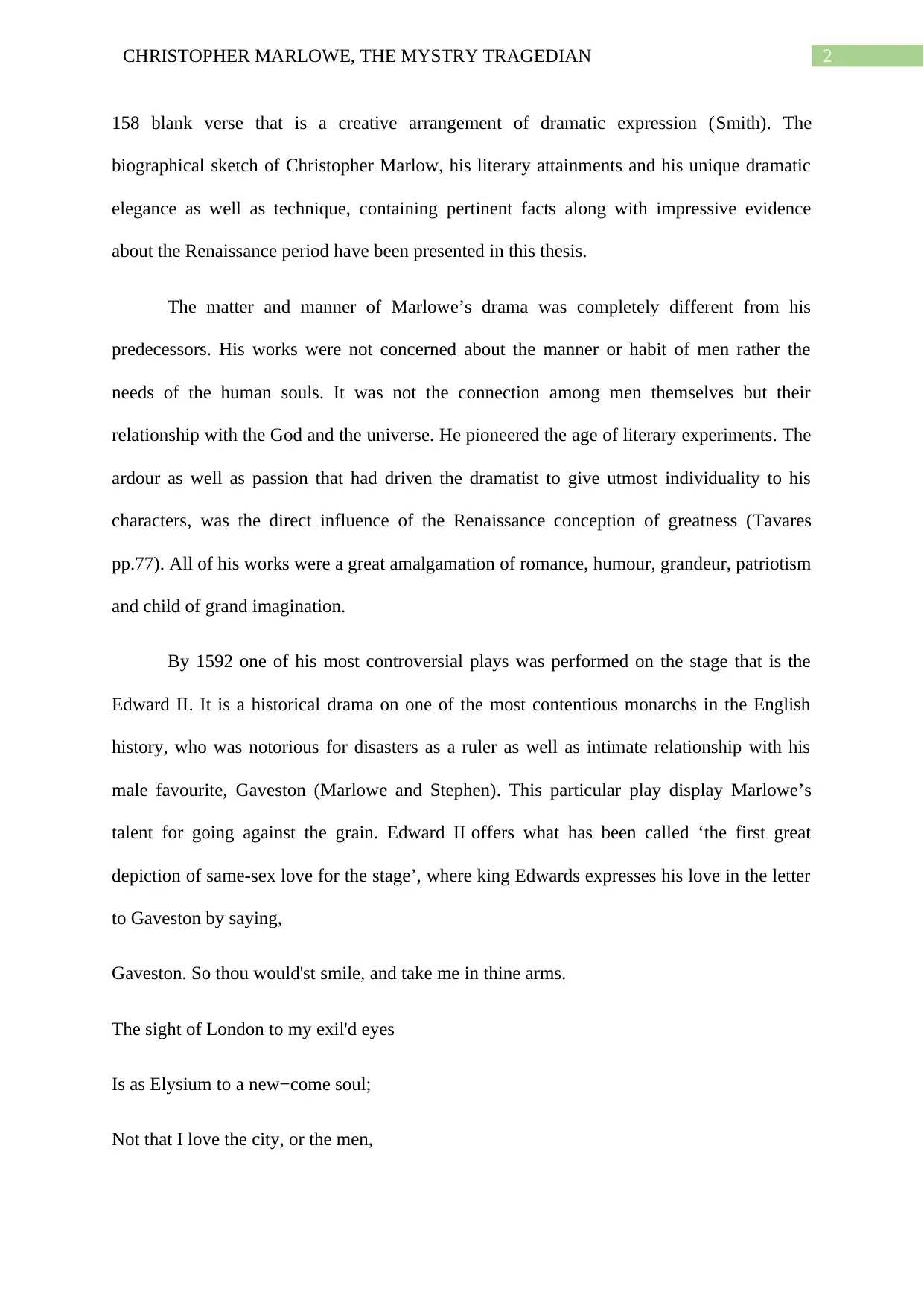
2CHRISTOPHER MARLOWE, THE MYSTRY TRAGEDIAN
158 blank verse that is a creative arrangement of dramatic expression (Smith). The
biographical sketch of Christopher Marlow, his literary attainments and his unique dramatic
elegance as well as technique, containing pertinent facts along with impressive evidence
about the Renaissance period have been presented in this thesis.
The matter and manner of Marlowe’s drama was completely different from his
predecessors. His works were not concerned about the manner or habit of men rather the
needs of the human souls. It was not the connection among men themselves but their
relationship with the God and the universe. He pioneered the age of literary experiments. The
ardour as well as passion that had driven the dramatist to give utmost individuality to his
characters, was the direct influence of the Renaissance conception of greatness (Tavares
pp.77). All of his works were a great amalgamation of romance, humour, grandeur, patriotism
and child of grand imagination.
By 1592 one of his most controversial plays was performed on the stage that is the
Edward II. It is a historical drama on one of the most contentious monarchs in the English
history, who was notorious for disasters as a ruler as well as intimate relationship with his
male favourite, Gaveston (Marlowe and Stephen). This particular play display Marlowe’s
talent for going against the grain. Edward II offers what has been called ‘the first great
depiction of same-sex love for the stage’, where king Edwards expresses his love in the letter
to Gaveston by saying,
Gaveston. So thou would'st smile, and take me in thine arms.
The sight of London to my exil'd eyes
Is as Elysium to a new−come soul;
Not that I love the city, or the men,
158 blank verse that is a creative arrangement of dramatic expression (Smith). The
biographical sketch of Christopher Marlow, his literary attainments and his unique dramatic
elegance as well as technique, containing pertinent facts along with impressive evidence
about the Renaissance period have been presented in this thesis.
The matter and manner of Marlowe’s drama was completely different from his
predecessors. His works were not concerned about the manner or habit of men rather the
needs of the human souls. It was not the connection among men themselves but their
relationship with the God and the universe. He pioneered the age of literary experiments. The
ardour as well as passion that had driven the dramatist to give utmost individuality to his
characters, was the direct influence of the Renaissance conception of greatness (Tavares
pp.77). All of his works were a great amalgamation of romance, humour, grandeur, patriotism
and child of grand imagination.
By 1592 one of his most controversial plays was performed on the stage that is the
Edward II. It is a historical drama on one of the most contentious monarchs in the English
history, who was notorious for disasters as a ruler as well as intimate relationship with his
male favourite, Gaveston (Marlowe and Stephen). This particular play display Marlowe’s
talent for going against the grain. Edward II offers what has been called ‘the first great
depiction of same-sex love for the stage’, where king Edwards expresses his love in the letter
to Gaveston by saying,
Gaveston. So thou would'st smile, and take me in thine arms.
The sight of London to my exil'd eyes
Is as Elysium to a new−come soul;
Not that I love the city, or the men,
⊘ This is a preview!⊘
Do you want full access?
Subscribe today to unlock all pages.

Trusted by 1+ million students worldwide
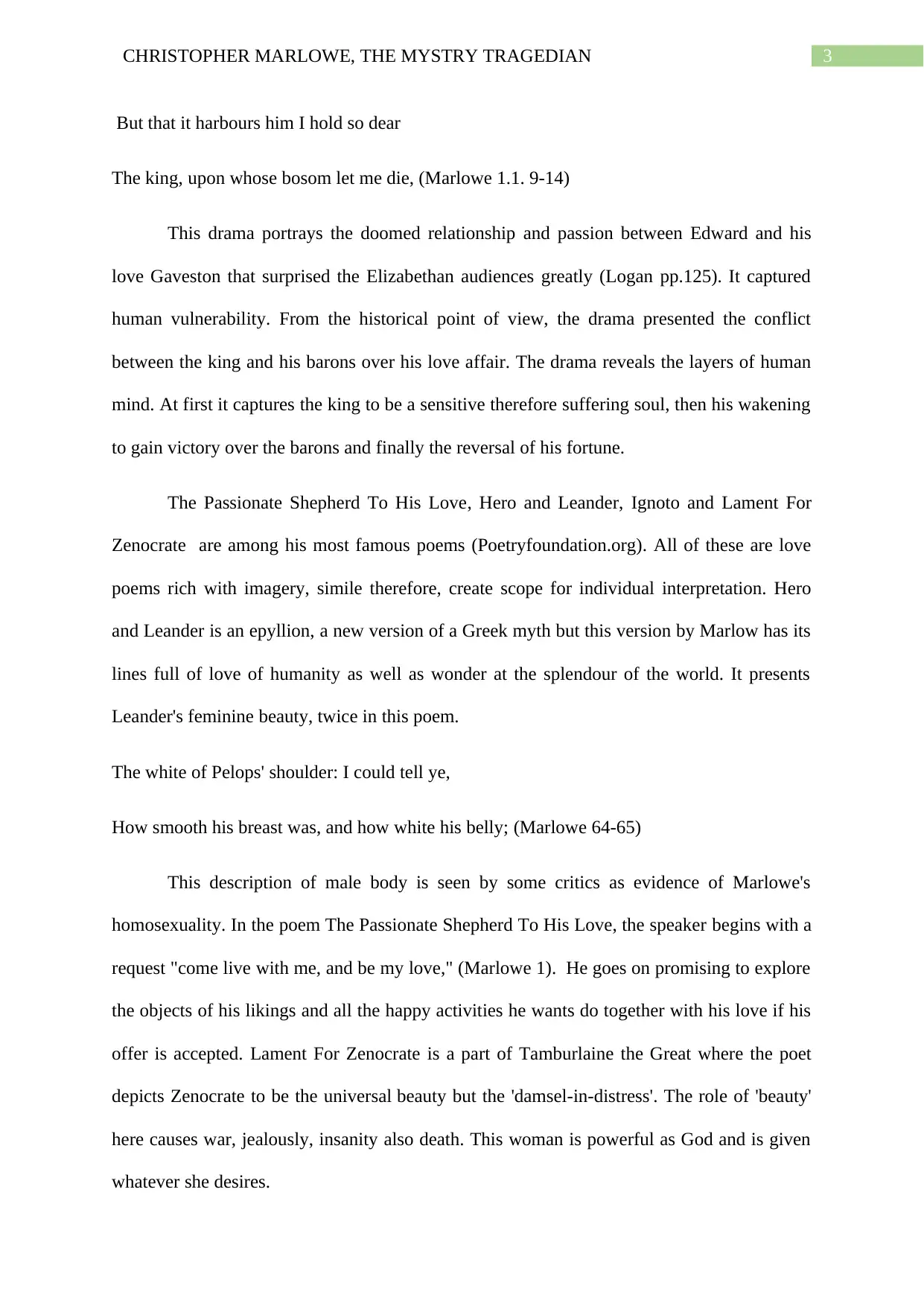
3CHRISTOPHER MARLOWE, THE MYSTRY TRAGEDIAN
But that it harbours him I hold so dear
The king, upon whose bosom let me die, (Marlowe 1.1. 9-14)
This drama portrays the doomed relationship and passion between Edward and his
love Gaveston that surprised the Elizabethan audiences greatly (Logan pp.125). It captured
human vulnerability. From the historical point of view, the drama presented the conflict
between the king and his barons over his love affair. The drama reveals the layers of human
mind. At first it captures the king to be a sensitive therefore suffering soul, then his wakening
to gain victory over the barons and finally the reversal of his fortune.
The Passionate Shepherd To His Love, Hero and Leander, Ignoto and Lament For
Zenocrate are among his most famous poems (Poetryfoundation.org). All of these are love
poems rich with imagery, simile therefore, create scope for individual interpretation. Hero
and Leander is an epyllion, a new version of a Greek myth but this version by Marlow has its
lines full of love of humanity as well as wonder at the splendour of the world. It presents
Leander's feminine beauty, twice in this poem.
The white of Pelops' shoulder: I could tell ye,
How smooth his breast was, and how white his belly; (Marlowe 64-65)
This description of male body is seen by some critics as evidence of Marlowe's
homosexuality. In the poem The Passionate Shepherd To His Love, the speaker begins with a
request "come live with me, and be my love," (Marlowe 1). He goes on promising to explore
the objects of his likings and all the happy activities he wants do together with his love if his
offer is accepted. Lament For Zenocrate is a part of Tamburlaine the Great where the poet
depicts Zenocrate to be the universal beauty but the 'damsel-in-distress'. The role of 'beauty'
here causes war, jealously, insanity also death. This woman is powerful as God and is given
whatever she desires.
But that it harbours him I hold so dear
The king, upon whose bosom let me die, (Marlowe 1.1. 9-14)
This drama portrays the doomed relationship and passion between Edward and his
love Gaveston that surprised the Elizabethan audiences greatly (Logan pp.125). It captured
human vulnerability. From the historical point of view, the drama presented the conflict
between the king and his barons over his love affair. The drama reveals the layers of human
mind. At first it captures the king to be a sensitive therefore suffering soul, then his wakening
to gain victory over the barons and finally the reversal of his fortune.
The Passionate Shepherd To His Love, Hero and Leander, Ignoto and Lament For
Zenocrate are among his most famous poems (Poetryfoundation.org). All of these are love
poems rich with imagery, simile therefore, create scope for individual interpretation. Hero
and Leander is an epyllion, a new version of a Greek myth but this version by Marlow has its
lines full of love of humanity as well as wonder at the splendour of the world. It presents
Leander's feminine beauty, twice in this poem.
The white of Pelops' shoulder: I could tell ye,
How smooth his breast was, and how white his belly; (Marlowe 64-65)
This description of male body is seen by some critics as evidence of Marlowe's
homosexuality. In the poem The Passionate Shepherd To His Love, the speaker begins with a
request "come live with me, and be my love," (Marlowe 1). He goes on promising to explore
the objects of his likings and all the happy activities he wants do together with his love if his
offer is accepted. Lament For Zenocrate is a part of Tamburlaine the Great where the poet
depicts Zenocrate to be the universal beauty but the 'damsel-in-distress'. The role of 'beauty'
here causes war, jealously, insanity also death. This woman is powerful as God and is given
whatever she desires.
Paraphrase This Document
Need a fresh take? Get an instant paraphrase of this document with our AI Paraphraser
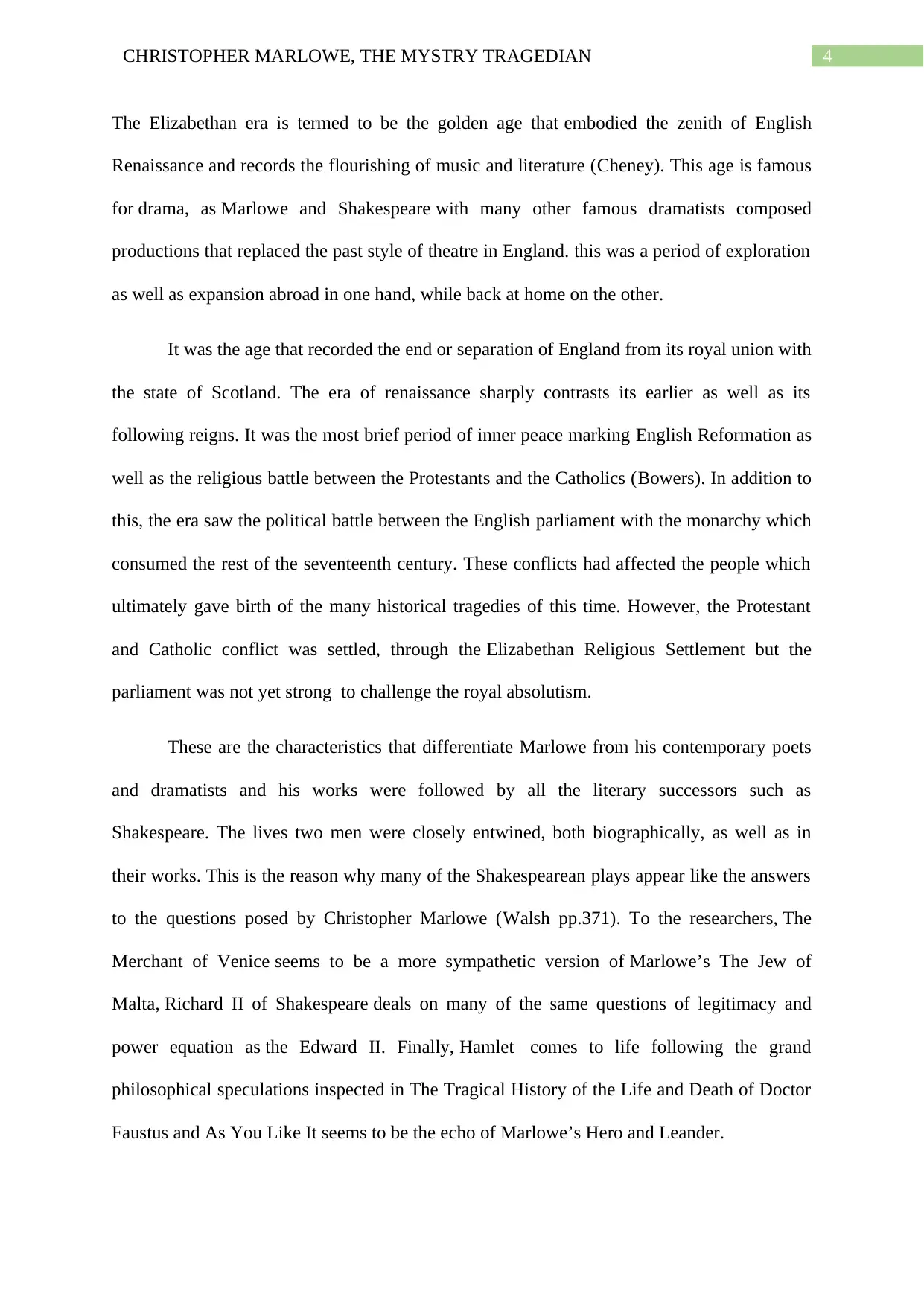
4CHRISTOPHER MARLOWE, THE MYSTRY TRAGEDIAN
The Elizabethan era is termed to be the golden age that embodied the zenith of English
Renaissance and records the flourishing of music and literature (Cheney). This age is famous
for drama, as Marlowe and Shakespeare with many other famous dramatists composed
productions that replaced the past style of theatre in England. this was a period of exploration
as well as expansion abroad in one hand, while back at home on the other.
It was the age that recorded the end or separation of England from its royal union with
the state of Scotland. The era of renaissance sharply contrasts its earlier as well as its
following reigns. It was the most brief period of inner peace marking English Reformation as
well as the religious battle between the Protestants and the Catholics (Bowers). In addition to
this, the era saw the political battle between the English parliament with the monarchy which
consumed the rest of the seventeenth century. These conflicts had affected the people which
ultimately gave birth of the many historical tragedies of this time. However, the Protestant
and Catholic conflict was settled, through the Elizabethan Religious Settlement but the
parliament was not yet strong to challenge the royal absolutism.
These are the characteristics that differentiate Marlowe from his contemporary poets
and dramatists and his works were followed by all the literary successors such as
Shakespeare. The lives two men were closely entwined, both biographically, as well as in
their works. This is the reason why many of the Shakespearean plays appear like the answers
to the questions posed by Christopher Marlowe (Walsh pp.371). To the researchers, The
Merchant of Venice seems to be a more sympathetic version of Marlowe’s The Jew of
Malta, Richard II of Shakespeare deals on many of the same questions of legitimacy and
power equation as the Edward II. Finally, Hamlet comes to life following the grand
philosophical speculations inspected in The Tragical History of the Life and Death of Doctor
Faustus and As You Like It seems to be the echo of Marlowe’s Hero and Leander.
The Elizabethan era is termed to be the golden age that embodied the zenith of English
Renaissance and records the flourishing of music and literature (Cheney). This age is famous
for drama, as Marlowe and Shakespeare with many other famous dramatists composed
productions that replaced the past style of theatre in England. this was a period of exploration
as well as expansion abroad in one hand, while back at home on the other.
It was the age that recorded the end or separation of England from its royal union with
the state of Scotland. The era of renaissance sharply contrasts its earlier as well as its
following reigns. It was the most brief period of inner peace marking English Reformation as
well as the religious battle between the Protestants and the Catholics (Bowers). In addition to
this, the era saw the political battle between the English parliament with the monarchy which
consumed the rest of the seventeenth century. These conflicts had affected the people which
ultimately gave birth of the many historical tragedies of this time. However, the Protestant
and Catholic conflict was settled, through the Elizabethan Religious Settlement but the
parliament was not yet strong to challenge the royal absolutism.
These are the characteristics that differentiate Marlowe from his contemporary poets
and dramatists and his works were followed by all the literary successors such as
Shakespeare. The lives two men were closely entwined, both biographically, as well as in
their works. This is the reason why many of the Shakespearean plays appear like the answers
to the questions posed by Christopher Marlowe (Walsh pp.371). To the researchers, The
Merchant of Venice seems to be a more sympathetic version of Marlowe’s The Jew of
Malta, Richard II of Shakespeare deals on many of the same questions of legitimacy and
power equation as the Edward II. Finally, Hamlet comes to life following the grand
philosophical speculations inspected in The Tragical History of the Life and Death of Doctor
Faustus and As You Like It seems to be the echo of Marlowe’s Hero and Leander.
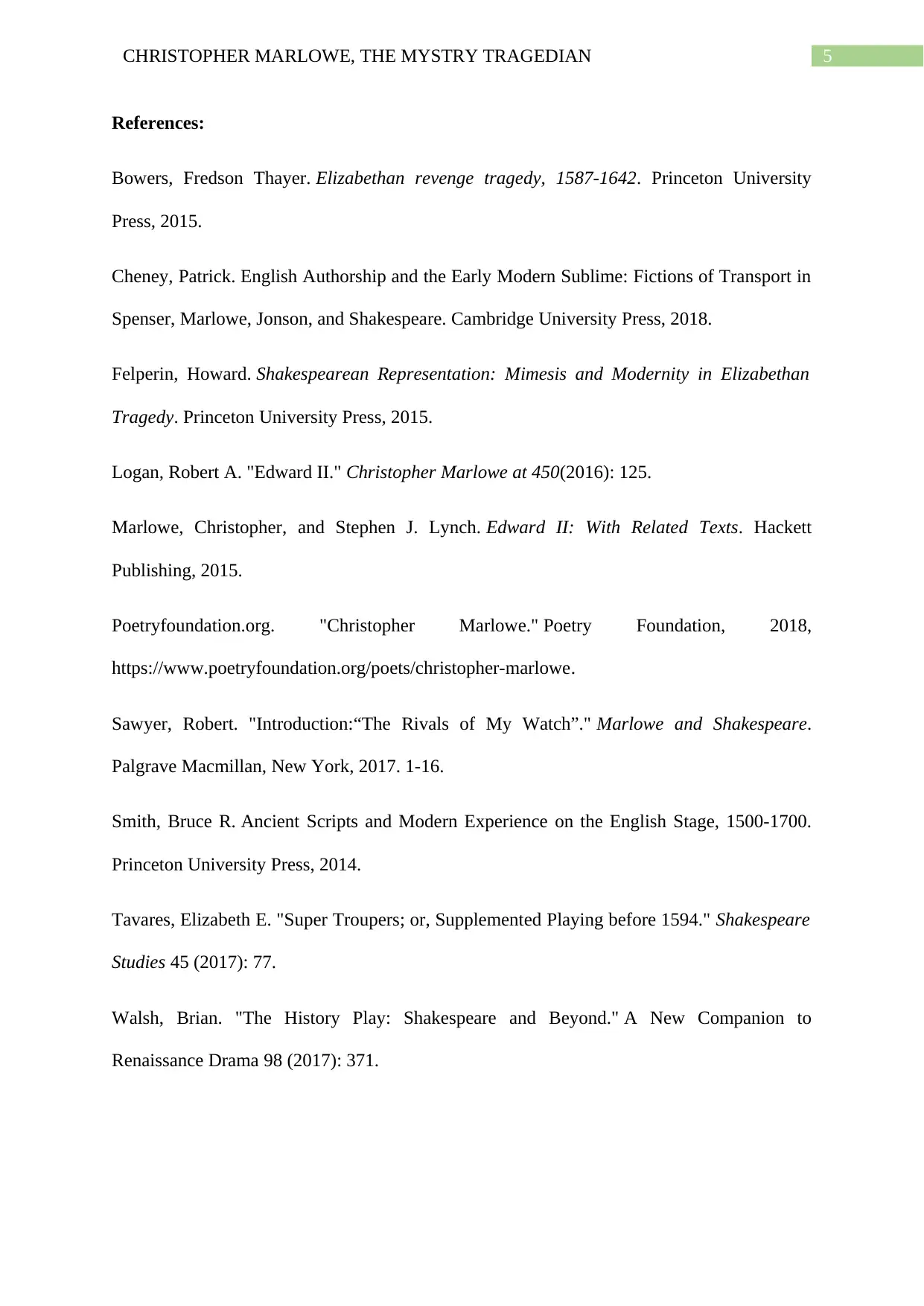
5CHRISTOPHER MARLOWE, THE MYSTRY TRAGEDIAN
References:
Bowers, Fredson Thayer. Elizabethan revenge tragedy, 1587-1642. Princeton University
Press, 2015.
Cheney, Patrick. English Authorship and the Early Modern Sublime: Fictions of Transport in
Spenser, Marlowe, Jonson, and Shakespeare. Cambridge University Press, 2018.
Felperin, Howard. Shakespearean Representation: Mimesis and Modernity in Elizabethan
Tragedy. Princeton University Press, 2015.
Logan, Robert A. "Edward II." Christopher Marlowe at 450(2016): 125.
Marlowe, Christopher, and Stephen J. Lynch. Edward II: With Related Texts. Hackett
Publishing, 2015.
Poetryfoundation.org. "Christopher Marlowe." Poetry Foundation, 2018,
https://www.poetryfoundation.org/poets/christopher-marlowe.
Sawyer, Robert. "Introduction:“The Rivals of My Watch”." Marlowe and Shakespeare.
Palgrave Macmillan, New York, 2017. 1-16.
Smith, Bruce R. Ancient Scripts and Modern Experience on the English Stage, 1500-1700.
Princeton University Press, 2014.
Tavares, Elizabeth E. "Super Troupers; or, Supplemented Playing before 1594." Shakespeare
Studies 45 (2017): 77.
Walsh, Brian. "The History Play: Shakespeare and Beyond." A New Companion to
Renaissance Drama 98 (2017): 371.
References:
Bowers, Fredson Thayer. Elizabethan revenge tragedy, 1587-1642. Princeton University
Press, 2015.
Cheney, Patrick. English Authorship and the Early Modern Sublime: Fictions of Transport in
Spenser, Marlowe, Jonson, and Shakespeare. Cambridge University Press, 2018.
Felperin, Howard. Shakespearean Representation: Mimesis and Modernity in Elizabethan
Tragedy. Princeton University Press, 2015.
Logan, Robert A. "Edward II." Christopher Marlowe at 450(2016): 125.
Marlowe, Christopher, and Stephen J. Lynch. Edward II: With Related Texts. Hackett
Publishing, 2015.
Poetryfoundation.org. "Christopher Marlowe." Poetry Foundation, 2018,
https://www.poetryfoundation.org/poets/christopher-marlowe.
Sawyer, Robert. "Introduction:“The Rivals of My Watch”." Marlowe and Shakespeare.
Palgrave Macmillan, New York, 2017. 1-16.
Smith, Bruce R. Ancient Scripts and Modern Experience on the English Stage, 1500-1700.
Princeton University Press, 2014.
Tavares, Elizabeth E. "Super Troupers; or, Supplemented Playing before 1594." Shakespeare
Studies 45 (2017): 77.
Walsh, Brian. "The History Play: Shakespeare and Beyond." A New Companion to
Renaissance Drama 98 (2017): 371.
⊘ This is a preview!⊘
Do you want full access?
Subscribe today to unlock all pages.

Trusted by 1+ million students worldwide
1 out of 6
Your All-in-One AI-Powered Toolkit for Academic Success.
+13062052269
info@desklib.com
Available 24*7 on WhatsApp / Email
![[object Object]](/_next/static/media/star-bottom.7253800d.svg)
Unlock your academic potential
Copyright © 2020–2025 A2Z Services. All Rights Reserved. Developed and managed by ZUCOL.
